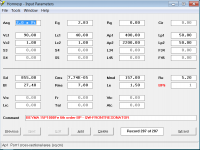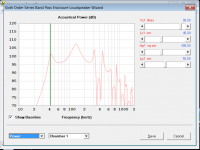Title says it all.
Found some thread about 4th order but not 6th...
What would be the pros and cons of such system?
For what i understand, the bandwith will be limited to approx. 1 octave, and then cabinet volume would be minimal (compared to port version) and also there will be no port resonance.
But will it worth it compared to classic BR w/passive ? in terms of pure output and/or extension...
Found some thread about 4th order but not 6th...
What would be the pros and cons of such system?
For what i understand, the bandwith will be limited to approx. 1 octave, and then cabinet volume would be minimal (compared to port version) and also there will be no port resonance.
But will it worth it compared to classic BR w/passive ? in terms of pure output and/or extension...
Large quarter wave resonators is much better then passive radiators. Much wider bandwidth and usually higher efficiency (less resistive losses).
If you feed a quarter wave resonator from a tapped pipe or tapped horn you get a ROAR. You can use a bassreflexbox to feed the front resonator for a normal series tuned 6th order bandpass.
Regards,
Johannes
If you feed a quarter wave resonator from a tapped pipe or tapped horn you get a ROAR. You can use a bassreflexbox to feed the front resonator for a normal series tuned 6th order bandpass.
Regards,
Johannes
A bandpass box is not a quarter wave resonator.
Pros of passive radiator are the same for bandpass boxes as for vented etc., about which a lot has been written.
Pros of passive radiator are the same for bandpass boxes as for vented etc., about which a lot has been written.
Last edited:
The lower you tune a bandpass, the lower it's center of bandwidth is. 6th order would have the same unloading below tuning as a vented box and group delay also akin to vented. The 4th order does not unload below lower F3, and has a sealed box group delay. You also get possible gain depending on design, reduced Xmax, and sometimes the box is smaller than the average vented box.
I'll be building a pair with SP10 and APR12 in about a cubic foot, that has F3 of 30 and 43Hz, and an output of about 110dB with 500W BASH amps. That's anechoic response, and the Xmax is not breached on either the driver or PR.
I'll be building a pair with SP10 and APR12 in about a cubic foot, that has F3 of 30 and 43Hz, and an output of about 110dB with 500W BASH amps. That's anechoic response, and the Xmax is not breached on either the driver or PR.
Possible? Yes, of course.
Practical? That's another matter.
A standard 6th order BP with a PR for each chamber might be a bit expensive and might be difficult to implement in practice.
However, a series-tuned 6th order BP with a vent between the chambers and a PR to the outside might be an interesting project.
The width of the passband will depend on how you've implemented the bandpass alignment. Note that wide bandwidths may look good on paper, when you examine the GD, they might not look so hot again and you start losing one of the advantages of BP designs - their ability to filter out audible distortion. A good 2.5 octaves should be achievable.
Practical? That's another matter.
A standard 6th order BP with a PR for each chamber might be a bit expensive and might be difficult to implement in practice.
However, a series-tuned 6th order BP with a vent between the chambers and a PR to the outside might be an interesting project.
The width of the passband will depend on how you've implemented the bandpass alignment. Note that wide bandwidths may look good on paper, when you examine the GD, they might not look so hot again and you start losing one of the advantages of BP designs - their ability to filter out audible distortion. A good 2.5 octaves should be achievable.
However, a series-tuned 6th order BP with a vent between the chambers and a PR to the outside might be an interesting project.
The width of the passband will depend on how you've implemented the bandpass alignment. Note that wide bandwidths may look good on paper, when you examine the GD, they might not look so hot again and you start losing one of the advantages of BP designs - their ability to filter out audible distortion. A good 2.5 octaves should be achievable.
2.5 octaves is actually pretty good, much more than expected i'd say...
It's more typical to get about an octave out of a bandpass without creating a loss in sensitivity, IME.
Wolf
Wolf
- Status
- Not open for further replies.
- Home
- Loudspeakers
- Subwoofers
- Any benefits doing a 6th order Bandpass with Passive Radiators?

